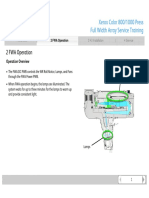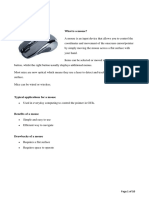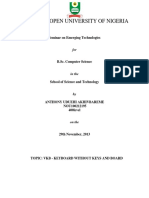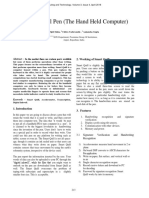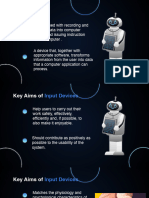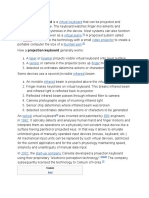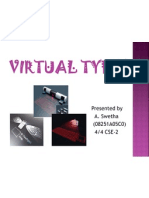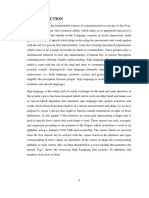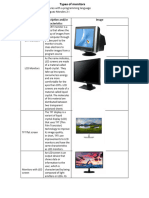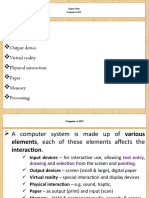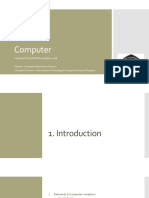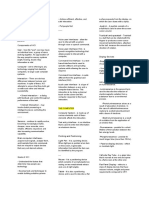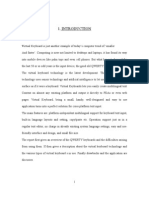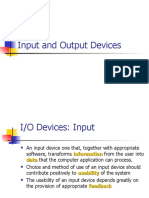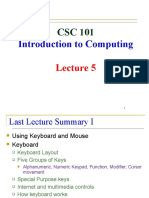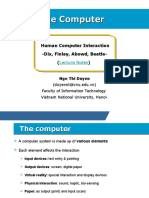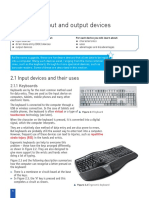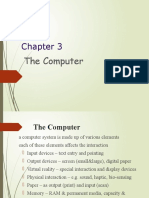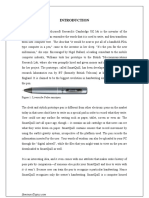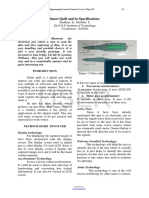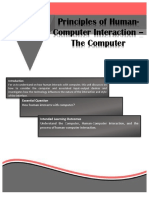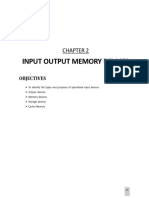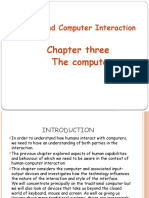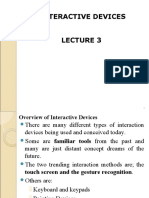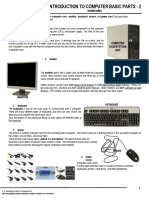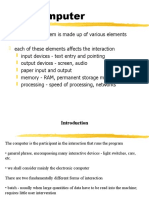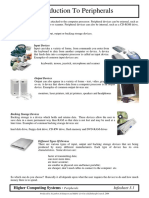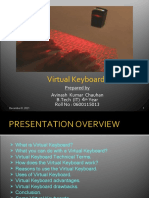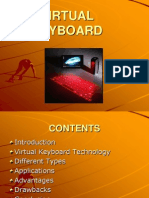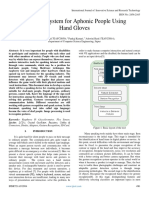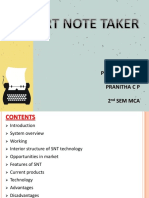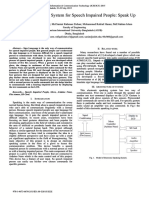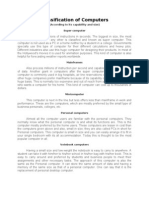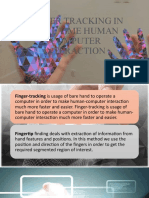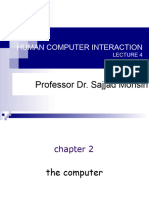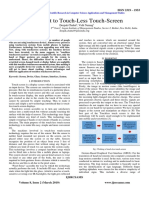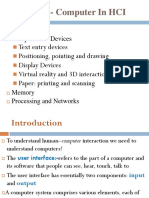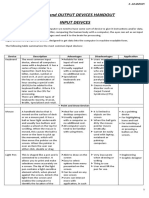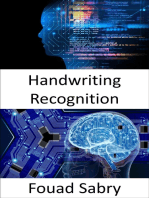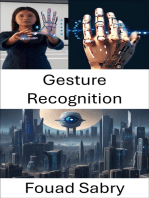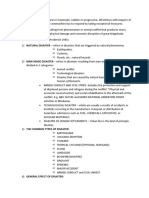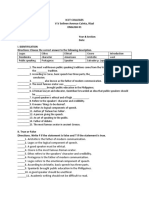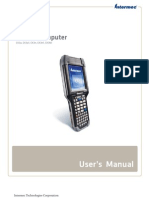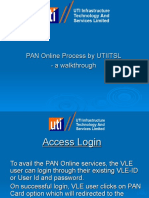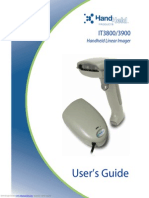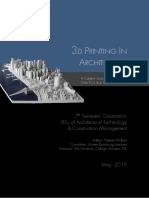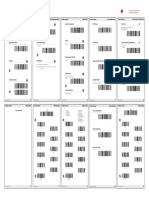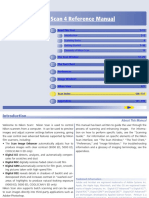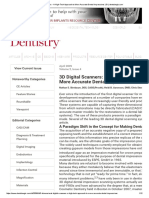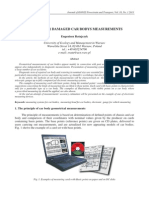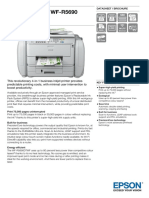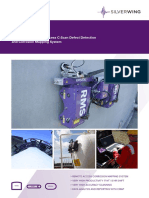Professional Documents
Culture Documents
Hci 1
Hci 1
Uploaded by
Erlyn Grace RedobladoOriginal Description:
Original Title
Copyright
Available Formats
Share this document
Did you find this document useful?
Is this content inappropriate?
Report this DocumentCopyright:
Available Formats
Hci 1
Hci 1
Uploaded by
Erlyn Grace RedobladoCopyright:
Available Formats
Chapter 2: The Computer
2.1 Introduction
Interaction (with or without computer) is a process of information transfer. The diversity of devices
reflects the fact that there are many different types of data that may be entered into and obtained
from a system, as there are many different users. In the early days, batch processing was common: a
large mass of information was dumped into and processed by the computer. Nowadays, computers
respond within milliseconds and computer systems are integrated in many different devices.
2.2 Text entry devices
2.2.1 The alphanumeric keyboard
The vast majority of keyboards have a standardized layout, known by the first six letters on the top
row: QWERTY. The non-alphanumeric keys are not standardized. This layout is not optimal for
typing, but dates from the time of mechanical limitations of the typewriter. Today, the keys can also
be arranged in alphabetic order (the alphabetic keyboard), but this does not improve typing
performance. The DVORAK keyboard does, placing the keys in a different order on a similar layout
as found on the QWERTY keyboards. The layout minimized the stretch of fingers and the use of
weak fingers, reducing fatigue and increasing typing speed (10-15%).
HCI-1: Human and Computer Interaction
2.2.2 Chord keyboards
On chord keyboards, only a few keys are used. Letters are produces
pressing multiple keys at once. They are smaller than conventional
keyboards and have a short learning time.
2.2.3 Phone pad and T9 entry
The numeric keys on a cellphone can be pressed more than
once to enter letters. Most phones have 2 keypad modes: a
numeric and an alphabetic mode. Most phones have additional
modes for entering (initial) capitals. On modern phones you can
also find the T9-algorithm. This uses a large dictionary to
disambiguate words by typing the relevant letters keys once.
2.2.4 Handwriting recognition
Current technology is still fairly inaccurate and makes a
lot of mistakes, partly due to the enormous differences
between people’s handwriting. HR deals mostly worth
stroke information: the way in which the letter is
drawn, not the letter itself. Therefore, online
recognition is most accurate. HR has the advantage of
size and accuracy over small keyboards and is therefore
often used in mobile computing.
HCI-1: Human and Computer Interaction
2.2.5 Speech recognition
The performance of speech recognition is still
relatively low, even for a restricted vocabulary.
Adjusting the system for use with natural language
gives birth to even more problems: the ‘errors’ in
natural language use, different voices, emotions
and accents etc. This means the system has to be
tuned for each different user. SR can be used in 3
scenarios: as an alternative text entry device,
replacing the keyboard in the current software,
with new software especially designed for SR and in
situations where the use of keyboards is impractical
or impossible.
2.3 Positioning, pointing and drawing
2.3.1 The mouse
The mouse is an indirect input device, because a transformation is required
to map from the horizontal nature of the desktop to the vertical alignment
of the screen. Invented in 1964 by Engelbart, his mouse used 2 wheels that
slid across the desktop and transmitted x; y-coordinates to the computer.
There have been experiments with foot-controlled mice.
2.3.2 Touchpad
Touchpads are touch-sensitive tablets, operated by sliding the
finger over it and are mostly used in notebook computers.
Performance can be increased using accelerators.
HCI-1: Human and Computer Interaction
2.3.3 Trackball and thumbwheel
A trackball is an upside-down mouse: instead of moving the device itself, the
ball is rolled to move the cursor. Trackballs are often used by RSI users.
Thumbwheels (in 2 dimensions) offer less usability because they can only
manipulate the horizontal and vertical movement of the cursor. 1-
dimensional thumbwheels are often included on the normal mice the
enhance the scrolling
2.3.4 Joystick and keyboard nipple
There are two types of joysticks: absolute sticks, in which the position of the
cursor corresponds to the position of the joystick in its base, and isometric
sticks, in which the pressure on the stick (in a
certain direction) controls the velocity of the
cursor in that direction.
Keyboard nipples are tiny joysticks that are sometimes used on
notebook computers.
HCI-1: Human and Computer Interaction
2.3.5 Touch-sensitive screens (touchscreens)
Touchscreens detect the position of the user’s finger or stylus on the
screen itself and are therefore very direct. They work by having the
finger/stylus interrupting a matrix of light beams, making capacitance
changes on a grid overlaying the screen or by ultrasonic reflections. It is
a direct device: no mapping is required. However the selection of small
areas is difficult and intensive use can be tiring
2.3.6 Stylus and lightpen
For more accurate positioning, systems with touch-sensitive surfaces often
emply a stylus. An older technology for the same purpose is the lightpen,
which emits radiation detected by the screen. A difficulty of this and other
direct devices is that pointing obscures the display, making it more difficult
to use in rapid successions.
2.3.7 Digitizing tablet
A device used for freehand drawing. A resistive tablet detects point
contact between two separated conducting sheets. Magnetic,
capacitive and electrostatic tablets use special pens. The sonic tablet
requires no pad: an ultrasonic sound emitted by the pen is detected
by 2 microphones.
2.3.8 Eye gaze
Eye gaze allows you to control the computer by looking at it, while
wearing special glasses, head mounted boxes etc. By tracking a laser
beam’s reflection in the eye, the direction in which the eye is looking
is determined. The system needs to be tuned and is very expensive,
but also very accurate.
HCI-1: Human and Computer Interaction
2.3.9 Cursor keys and discrete positioning
For 2D-navigation,
cursor keys can sometimes be preferable. The same goes for remote-controls and
cellphones.
2.4 Display devices
2.4.1 Bitmap displays, resolution and color
A bitmap-base means that the display is made of a fixed number of dots or pixels in a rectangular
grid. The color or intensity at each pixel is held by the ’computer’s video card. The more bits per
pixel, the more colors/intensities are possible. Also is the resolution of the screen: the total number
of pixels (in a 4:3-ratio) and the density of the pixels. Anti-alinsing: softening the edges of line
segments, blurring the discontinuity and making the juggles less obvious.
2.4.2 Technologies
In a CRT-monitor a stream of electrons is emitted from an electron gun, which is than focused and
directed by magnetic fields. As the beam hits the phosphor- coated screen, the phosphor is excited
by the electrons and glows. Flicker can be reduced by increasing the scanning rate or by interlacing,
in which odd lines are scanned first, followed by even lines. In LCD’s a thin layer of liquid crystals is
sandwiched between two glass plates. External light passes through the top plate and is polarized.
This passes through the crystal and is reflected back to the user’s eye by the bottom plate. The
polarization of each single crystal can be turned electronically.
2.4.3 Large displays and situated displays
There are several types of large displays. Some use gas-plasma technology and usually have a 16:9-
ratio. Several smaller screens can also be places together in a video wall. Projectors are possible too,
in two variants: projectors with 3 lenses (red, green and blue) can build a full-color image. LCD
projectors have a small screen, through which light is projected on a screen.
HCI-1: Human and Computer Interaction
2.4.4 Digital paper
Thin flexible material that can be written to electronically, but keeps its contents when removed
from the power supply.
2.5 Devices for virtual reality and 3D interaction
2.5.1 Positioning in 3D
Changing from 2D to VR does not mean going to 3 degrees of freedom, but (sometimes) to 6,
because except for moving in 3 dimensions, you can also roll, turn, twist etc. Humans can use a 3D
environment with a 2D-device (mouse). The human mind is therefore capable of handling multiple
degrees of indirection. A 3D-input device is the 3D-mouse, which has 6 degrees of freedom: 3 for
position (x,y,z), 1 for pitch, yawn and roll. However, sometimes its better to use a data glove: a lycra
glove with fibers laid around the fingers, detecting the joint angles of the fingers and thumb. The
position of the head can be tracked using a VR-helmed, which can also display the 3D-world to each
eye. With other devices, e.g. special clothing or a modified trampoline, the position and movement
of the whole body can be tracked.
2.5.2 3D displays
3D can be displayed on normal screens using shadows, depth etc. It is also possible to generate the
natural stereoscopic images for both eye positions and have them delivered to the eyes using a VR
helmed. Finally, users can enter a VR cave, where the VR world is projected around them. If the VR
system performances too slow, and there is a delay between movement and image, disorientation
and sickness may occur.
2.6 Physical controls, sensors and special devices
2.6.1 Special displays
Except for CRT and LCD, there are numerous other display devices, e.g. LED’s, ganges, dials and
head-up displays.
2.6.2 Sound output
We do not yet know how to utilize sound in a sensible way to achieve maximum effects and
information transference in HCI. However, by having sounds confirm a right action, we can speed up
interaction.
HCI-1: Human and Computer Interaction
2.6.3 Touch, feel and smell
Force feedback gives different amounts of resistance to an input device depending on the state of
the virtual operation. Haptic devices are various forms of force, resistance and texture influencing
our physical senses.
2.6.4 Physical controls
Not only the function of controls, but also the physical design is important and needs to suit the
situation in which it is used: kitchen equipment, for example, needs controls that can be cleaned
easily.
2.6.5 Environment and bio-sensing
There are many sensors in our environment monitoring our behavior. Their measurements range
from temperature and movement to the user’s emotional state.
2.7 Paper: printing and scanning
2.7.1 Printing
The most common printers nowadays are dot-based. In order of increasing resolution, familiar types
are dot-matrix printers, ink-jet printers and laser printers.
2.7.2 Fonts and page description languages
Some printers print ASCII-characters and bitmaps by itself. Many more complex documents are
translated into suitable bitmaps by the computer. More sophisticated printers can accept a page
description language, e.g. PostScript. The programming-language for printing includes standard
programming constructs, which means that less data has to be sending to the printer in comparison
to using a bitmap.
2.7.3 Screen and page
There are many differences (e.g. size, color depth, resolution etc.) between a paper print and a
computer monitor, which causes problems when designing WYSIWYG-software. Especially the
correct alignment of text (in different fonts) is difficult.
2.7.4 Scanners and optical character recognition
Scanners produce a bitmap image from a ‘hard’ original and can, using optical character recognition,
transfer a page of text directly into a txt-file. There are 2 kinds of scanners: flat-bed (as in a copie
machine) and hand-held (as in a fax machine; however the scanner has to be manually pulled over
the paper). Scanners shine a beam of light at the page and record the intensity and color of the
reflection. The resolution of the scanner can differ highly between different types.
HCI-1: Human and Computer Interaction
2.8 Memory
2.8.1 RAM and short-term memory
(STM)
Most current active information is held in the random
access memory (RAM). RAM is volatile: contents are
lost when the power is turned off.. However, there are
more expensive or low-power consuming memory
techniques that can hold their contents when the
power is off.
2.8.2 Disks and long-term memory (LTM)
There are 2 main techniques used in disks: magnetic disks (floppy,
hard disk, tape) and optical disks. (CD-ROM/DVD). In comparison to
RAM, the computers LTM is rather slow.
2.8.3 Understanding speed and capacity
The capacity of RAM is limited and therefore multitask-systems tend to swap background-running
programs from RAM to the hard disk. When the program is fully activated it has to be swapped
back, which can cause delays (von Neumann bottleneck).
2.8.4 Compression
Compression techniques can be used to reduce the amount of storage required for text, bitmaps
and video. In text, logical contractions in the sentence can be replaced by a short code. In video,
differences between frames can be recorded instead of the whole frames. If fractal compression is
used, the quality can even improve in the process.
2.8.5 Storage format and standards
The basic standard for text storage is the ASCII character codes, which assign to each standard
printable character and several control characters an internationally recognized 7 bit code. UNICODE
is an extended version of this system and can also code for foreign characters. However, this is all
unformatted text. All editors which produce formatted texts have their own file format. Also for
images there exists a wide range of formats.
2.8.6 Methods of access
Standard database access is by special key fields with an associated index. The user has to know the
key before the system can find the information. Indices on databases are limited due to the storage
costs, privacy and security. The user’s mistakes in searching can be compensated by using forgiving
systems, for example by matching a key to a database index which corresponds closely.
HCI-1: Human and Computer Interaction
2.9 Processing and networks
2.9.1 Effects of finite processor speed
The processing speed of an interactive system can affect the user by being too slow (which can be
avoided by using buffers) or too fast. The faults can be functional, in which the program does the
wrong action. Slow responses from the system can also cause the so called cursor tracking and icon
wars. If the system is too fast, the user will not have enough time to interpret the system’s output.
2.9.2 Limitations on interactive performance
Several factors that can limit the speed of an interactive system.
They can be:
• Computation bound: Make sure the user has an indication of the system’s progress. •
Storage channel bound: Select the best fitting kind of memory and access technique. •
Graphics bound: The actual time of graphic operations can differ much from the estimates. •
Network capacity
2.9.3 Network computing
Networked systems have an effect on interactivity, because the large distances may cause a
noticeable delay in response from the system. The actions of other users may also influence your
own interaction with the connected computers
Summary
Computer system comprises various elements, each of which affects the user of the system.
• Input devices for interactive use, allowing text entry, drawing and selection from the screen:
o text entry: traditional keyboard, phone text entry, speech and handwriting
o pointing: principally the mouse, but also touchpad, stylus, and others
o 3D interaction devices
• Output display devices for interactive use:
o different types of screen mostly using some form of bitmap display
o large displays and situated displays for shared and public use
o digital paper may be usable in the near future
• Virtual reality systems and 3D visualization have special interaction and display devices. •
Various devices in the physical world:
o physical controls and dedicated displays
o sound, smell and haptic feedback
o sensors for nearly everything including movement, temperature, bio-signs
• Paper output and input: the paperless office and the less-paper office:
o different types of printers and their characteristics, character styles and fonts
o scanners and optical character recognition
• Memory:
o short-term memory: RAM
HCI-1: Human and Computer Interaction
o long-term memory: magnetic and optical disks
o capacity limitations related to document and video storage
o access methods as they limit or help the user
• Processing:
o the effects when systems run too slow or too fast, the myth of the infinitely fast
machine
o limitations on processing speed
o networks and their impact on system performance
For more information, please follow the links below:
https://hcibook.com/e3/plain/chaps/ch2
https://www.slideshare.net/alanjohndix/hci-chapter-2
HCI-1: Human and Computer Interaction
You might also like
- Xerox Color 800/1000 Press Full Width Array Service TrainingDocument58 pagesXerox Color 800/1000 Press Full Width Array Service Traininga4rfanNo ratings yet
- Squirt GuideDocument12 pagesSquirt GuideMicu LaurentiuNo ratings yet
- Ambo University Woliso CampusDocument14 pagesAmbo University Woliso CampusTolosa TafeseNo ratings yet
- Input Devices-1Document10 pagesInput Devices-1Moodely RuskynNo ratings yet
- An Overview of Smart QuillDocument3 pagesAn Overview of Smart QuillmythiliNo ratings yet
- Human Computer InteractionDocument31 pagesHuman Computer Interactionsubbu lakshmiNo ratings yet
- Module 1 Topic 2Document15 pagesModule 1 Topic 2Hillary MurungaNo ratings yet
- Virtual Keyboard Without Keys and BoardDocument13 pagesVirtual Keyboard Without Keys and Boardmahera KhatoonNo ratings yet
- Smart Quill Pen (The Hand Held Computer)Document4 pagesSmart Quill Pen (The Hand Held Computer)Priya HPNo ratings yet
- HCI-The ComputerDocument24 pagesHCI-The ComputerBerto BaluyoNo ratings yet
- Computer DevicesDocument19 pagesComputer DevicesosipashuraNo ratings yet
- Seminar ESDDocument14 pagesSeminar ESDSahana KiniNo ratings yet
- Virtual Keyboard: P-IsmDocument40 pagesVirtual Keyboard: P-Ismnakamo_idNo ratings yet
- Elements of Computer SystemDocument3 pagesElements of Computer Systemheartpassion2585% (13)
- Presented by A. Swetha (08251A05C0) 4/4 CSE-2Document23 pagesPresented by A. Swetha (08251A05C0) 4/4 CSE-2vinaykarnamNo ratings yet
- Part 4Document40 pagesPart 4Ravi Kumar100% (1)
- Types of Monitors, Keyboards and MouseDocument6 pagesTypes of Monitors, Keyboards and MouseScribdTranslationsNo ratings yet
- HCI Chapter 3Document25 pagesHCI Chapter 3AschenakiNo ratings yet
- HCI (3) ComputerDocument51 pagesHCI (3) ComputerDaniel Bintang PrikitewNo ratings yet
- The Computer: Human-Computer Interaction (HCI)Document76 pagesThe Computer: Human-Computer Interaction (HCI)Habtamu AbateNo ratings yet
- AcclaDocument3 pagesAcclaBea Louraine RiveraNo ratings yet
- Virtual Keyboard Seminar ReportDocument24 pagesVirtual Keyboard Seminar Reportlittlerasikan100% (1)
- INPUT AND OUTPUT DEVICES - Keit103Document19 pagesINPUT AND OUTPUT DEVICES - Keit103anshuman singhNo ratings yet
- Topic 2-Computer HardwareDocument42 pagesTopic 2-Computer HardwareJoram BwambaleNo ratings yet
- IO Devices (EDocFind - Com)Document15 pagesIO Devices (EDocFind - Com)Mohit GoyalNo ratings yet
- Keyboard Without Keys and Board 13092013125312 Keyboard Without Keys and BoardDocument4 pagesKeyboard Without Keys and Board 13092013125312 Keyboard Without Keys and BoardpanessonNo ratings yet
- Seminar Report On Keyboard Without Keys and BoardDocument4 pagesSeminar Report On Keyboard Without Keys and BoardBhagyashree PawaleNo ratings yet
- Lecture 5Document40 pagesLecture 5latest moviesNo ratings yet
- 3-The Computer 1Document35 pages3-The Computer 1Tiến PhạmNo ratings yet
- Input Output DevicesDocument34 pagesInput Output Devicesneil jhamnaniNo ratings yet
- Chapter 3Document81 pagesChapter 3Chala AmenuNo ratings yet
- Smart Quill 07012013141336 Smart QuillDocument10 pagesSmart Quill 07012013141336 Smart QuillMacdonald JosephNo ratings yet
- Smart Quill and Its SpecificationsDocument3 pagesSmart Quill and Its SpecificationsDeepakNo ratings yet
- HCI 101 - PrinciplesofHumanComputerInteractionTheComputer - Unit2 - PamintuanSherileneDocument12 pagesHCI 101 - PrinciplesofHumanComputerInteractionTheComputer - Unit2 - PamintuanSherileneJazzy ReigNo ratings yet
- Input Output Memory Devices: ObjectivesDocument22 pagesInput Output Memory Devices: Objectivestanisharavind777No ratings yet
- Notes Chapter 02Document8 pagesNotes Chapter 02nirikdhaNo ratings yet
- HCI Chap 3Document34 pagesHCI Chap 3alemneh bayehNo ratings yet
- Human and Computer Interaction: Chapter Three The ComputerDocument25 pagesHuman and Computer Interaction: Chapter Three The ComputerDafuq MaloneNo ratings yet
- Smart QuillDocument5 pagesSmart Quill63Swaleha PatelNo ratings yet
- ICT Theory Notes (Chapter 2)Document25 pagesICT Theory Notes (Chapter 2)Ahmad SamiNo ratings yet
- HCI-lecture 3Document23 pagesHCI-lecture 3joelNo ratings yet
- Intro Basic Computer PartsDocument3 pagesIntro Basic Computer PartsZdehc Oilut YajNo ratings yet
- By Mr. Walusimbi Kenneth: Information & Communication Technology Input and Output Devices - Part 1 (Input Devices)Document32 pagesBy Mr. Walusimbi Kenneth: Information & Communication Technology Input and Output Devices - Part 1 (Input Devices)Solángé MirembeNo ratings yet
- Computer IntroDocument45 pagesComputer IntrosssritNo ratings yet
- Types: Navigation Search Projection Keyboard Provide An Accessible OverviewDocument35 pagesTypes: Navigation Search Projection Keyboard Provide An Accessible OverviewTapasya MishraNo ratings yet
- I PeripheralsDocument23 pagesI PeripheralsEllie Ann GamillaNo ratings yet
- Virtual Keyboard: Prepared by Avinash Kumar Chauhan B.Tech (IT) 4 Year Roll NoDocument18 pagesVirtual Keyboard: Prepared by Avinash Kumar Chauhan B.Tech (IT) 4 Year Roll Noits4othersNo ratings yet
- Virtual KeyboardsDocument17 pagesVirtual KeyboardsMajid AbdulNo ratings yet
- Smart QuillDocument16 pagesSmart QuillManjusha RaoNo ratings yet
- Speaking System For Aphonic People Using Hand GlovesDocument4 pagesSpeaking System For Aphonic People Using Hand GlovesInternational Journal of Innovative Science and Research TechnologyNo ratings yet
- Smart Note Taker PPT 578efd034544dDocument33 pagesSmart Note Taker PPT 578efd034544dShreya ReddyNo ratings yet
- Electronic Speaking System For Speech Impaired PeopleDocument4 pagesElectronic Speaking System For Speech Impaired Peoplekarenheredia18No ratings yet
- Classification of ComputersDocument5 pagesClassification of Computerspolaris1543No ratings yet
- Multi-Touch Screen: Jcordero@est - Ups.edu - Ec Jpintadoy@est - Ups.edu - Ec, Jrodriguez@est - Ups.edu - EcDocument3 pagesMulti-Touch Screen: Jcordero@est - Ups.edu - Ec Jpintadoy@est - Ups.edu - Ec, Jrodriguez@est - Ups.edu - EcAlex PintadoNo ratings yet
- Finger Tracking in Real Time Human Computer InteractionDocument16 pagesFinger Tracking in Real Time Human Computer InteractionMara AndyNo ratings yet
- Hci Lecture 4Document89 pagesHci Lecture 4dihilo2240No ratings yet
- Ijsrcsamsv 8 I 2 P 122Document2 pagesIjsrcsamsv 8 I 2 P 122526 Vani BoligarlaNo ratings yet
- Chap 2Document45 pagesChap 2OetyNo ratings yet
- HCI - Chapter 3 - Computer in HCIDocument28 pagesHCI - Chapter 3 - Computer in HCIPro Nebyu100% (1)
- INPUT and OUTPUT DEVICES HANDOUTDocument6 pagesINPUT and OUTPUT DEVICES HANDOUTAlicia HaughtonNo ratings yet
- NSTP 2 Midterm Exam CoverageDocument3 pagesNSTP 2 Midterm Exam CoverageErlyn Grace RedobladoNo ratings yet
- Application of Conic SectionsDocument6 pagesApplication of Conic SectionsErlyn Grace RedobladoNo ratings yet
- Review of The Related Literature: Definition and Nature of Some Home ChemicalsDocument11 pagesReview of The Related Literature: Definition and Nature of Some Home ChemicalsErlyn Grace RedobladoNo ratings yet
- TulaDocument2 pagesTulaErlyn Grace RedobladoNo ratings yet
- Icct Colleges V.V Soliven Avenue Cainta, Rizal English 01Document5 pagesIcct Colleges V.V Soliven Avenue Cainta, Rizal English 01Erlyn Grace RedobladoNo ratings yet
- Percentile Rank Formula Excel TemplateDocument5 pagesPercentile Rank Formula Excel TemplateErlyn Grace RedobladoNo ratings yet
- Cainta Subjects Offered 3t1819Document30 pagesCainta Subjects Offered 3t1819Erlyn Grace RedobladoNo ratings yet
- CK3 User ManualDocument135 pagesCK3 User ManualfavoyouNo ratings yet
- PAN Online ProcessDocument27 pagesPAN Online ProcessAnonymous 3vj2VqNo ratings yet
- Photo Developing and Printing DigitalDocument28 pagesPhoto Developing and Printing DigitalKashif SaeedNo ratings yet
- VWR - Safety Catalogue - EN PDFDocument378 pagesVWR - Safety Catalogue - EN PDFSandra LuizNo ratings yet
- User's Guide: Handheld Linear ImagerDocument164 pagesUser's Guide: Handheld Linear ImagerAlienzNo ratings yet
- WOL N7C34 Supplementary Specifications Section 72Document37 pagesWOL N7C34 Supplementary Specifications Section 72kokueiNo ratings yet
- Organize Your GenealogyDocument14 pagesOrganize Your Genealogyjbduggan80% (15)
- Lunar Prodigy - RepairedDocument97 pagesLunar Prodigy - RepairedgustavoNo ratings yet
- 3D Printing in Architecture - A Current PDFDocument105 pages3D Printing in Architecture - A Current PDFHarshit SethiaNo ratings yet
- CordlessScannerSetupCards v1.10Document2 pagesCordlessScannerSetupCards v1.10balaznNo ratings yet
- B Thesis PDFDocument4 pagesB Thesis PDFKaye DitanNo ratings yet
- Nikon Scan 4 Reference ManualDocument139 pagesNikon Scan 4 Reference ManualJuan Sanchez GutierraNo ratings yet
- Es853 850 SH v10 PDFDocument650 pagesEs853 850 SH v10 PDFPhong DoanNo ratings yet
- M337x 387x 407x Release Note EnglishDocument3 pagesM337x 387x 407x Release Note EnglishIoana Codrea OrtelecanNo ratings yet
- 20.2 User's Guide: Document Imaging SolutionsDocument93 pages20.2 User's Guide: Document Imaging SolutionsHimanshi GuptaNo ratings yet
- Introduction To GISDocument56 pagesIntroduction To GISSudharsananPRSNo ratings yet
- OPenkm Scanner-ToolDocument56 pagesOPenkm Scanner-ToolFikruKidaneNo ratings yet
- HP B110a SpecDocument2 pagesHP B110a SpecWidi SasongkoNo ratings yet
- 3D Digital Scanners - A High-Tech Approach To More Accurate Dental Impressions - ID - DentalaegisDocument12 pages3D Digital Scanners - A High-Tech Approach To More Accurate Dental Impressions - ID - DentalaegismujtabaNo ratings yet
- 2011 Ratajczyk Systems For DamageDocument6 pages2011 Ratajczyk Systems For DamageDaniel MihaiNo ratings yet
- Datasheet CWL L enDocument2 pagesDatasheet CWL L enGifany BudimanNo ratings yet
- CX6040D DatasheetDocument2 pagesCX6040D DatasheetSanjay LohodasanNo ratings yet
- WorkForce Pro WF R5690 DTWF DatasheetDocument2 pagesWorkForce Pro WF R5690 DTWF DatasheetGabiNo ratings yet
- Rms Auto Ut Corrosion Mapping PDFDocument6 pagesRms Auto Ut Corrosion Mapping PDFSangeeth Kavil PNo ratings yet
- Distance Measurement Based On Pixel Variation of CCD ImagesDocument7 pagesDistance Measurement Based On Pixel Variation of CCD ImagesTommy FuNo ratings yet
- BridgeMaster E Quick ReferenceDocument1 pageBridgeMaster E Quick ReferencePaulina WójcińskaNo ratings yet
- Software OperationDocument76 pagesSoftware OperationAndrzej StrupiechowskiNo ratings yet
